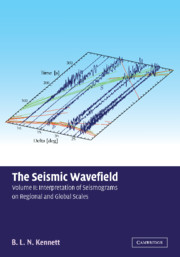Preface to Volume II
Published online by Cambridge University Press: 31 August 2019
Summary
As noted in volume I, the inspiration for this book came from the remarkable set of articles by Beno Gutenberg in the Handbuch der Geophysik, particularly vol. 4, 1932. Gutenburg provided a comprehensive summary of the current theory and accompanied this with a discussion of the nature of seismic observations.
This second volume of The Seismic Wavefield is primarily devoted to the interpretation of observed seismograms in terms of the physical processes which control their properties, with a strong link to the theoretical development in the first volume. References to sections in the first volume are indicated using a section marker (e.g., § I:3.1.2) and for equations from the earlier volume the volume number is represented explicitly as in (I:14.2.1). The emphasis throughout the book is on body waves and surface waves with frequencies above 10 mHz, rather than phenomena which are best treated through a normalmode development for the whole Earth, which are well covered in Theoretical Global Seismology by Dahlen & Tromp (1998).
The treatment starts with a discussion of near-source effects and strong ground motion. Then attention is directed to the wavefield as seen at progressively larger distances. For regional ranges, out to 1000 km from the source, the properties of the crust and uppermost mantle play an important role. In the far-regional range, for epicentral distances from 1000 km to 3000 km, the complex interactions with upper mantle discontinuities dictate the character of P and S arrivals. For larger epicentral distances a global perspective is appropriate, but surface multiples still carry relatively shallowly propagating waves to substantial distances.
The introduction to the discussion of seismic wave propagation across the globe was strongly influenced by the 2 m long wall chart From Earthquake to Seismogram prepared in 1962 under the direction of the late Professor S. Warren Carey at the University of Tasmania. In this chart the wavefronts of body waves and surface waves are carefully mapped through the Earth and across its surface, and these wavefronts are related to the features of a seismogram from an earthquake in the Kuriles recorded at the Hobart Observatory in Tasmania.
- Type
- Chapter
- Information
- The Seismic WavefieldVolume II: Interpretation of Seismograms on Regional and Global Scales, pp. xi - xiiPublisher: Cambridge University PressPrint publication year: 2002



